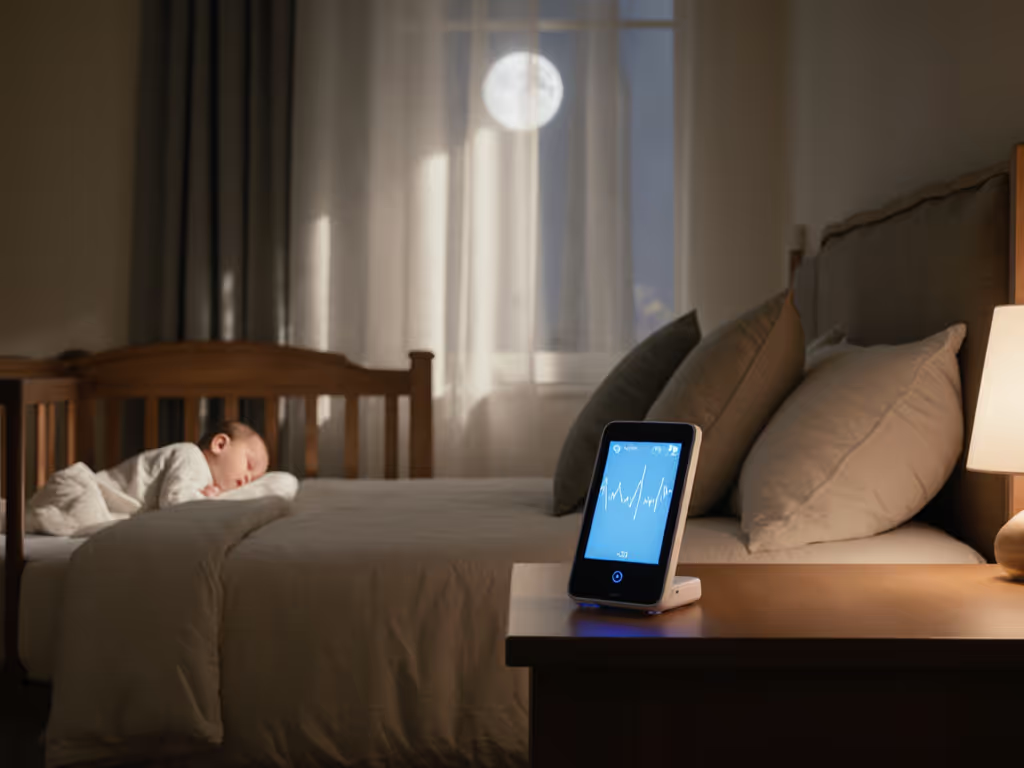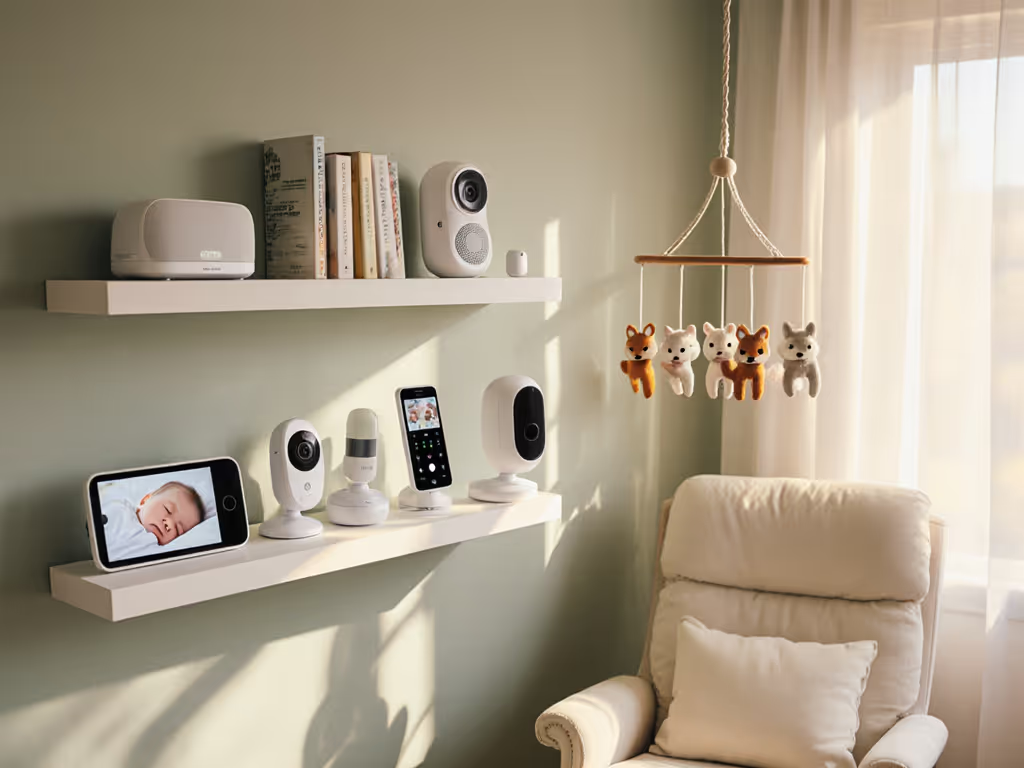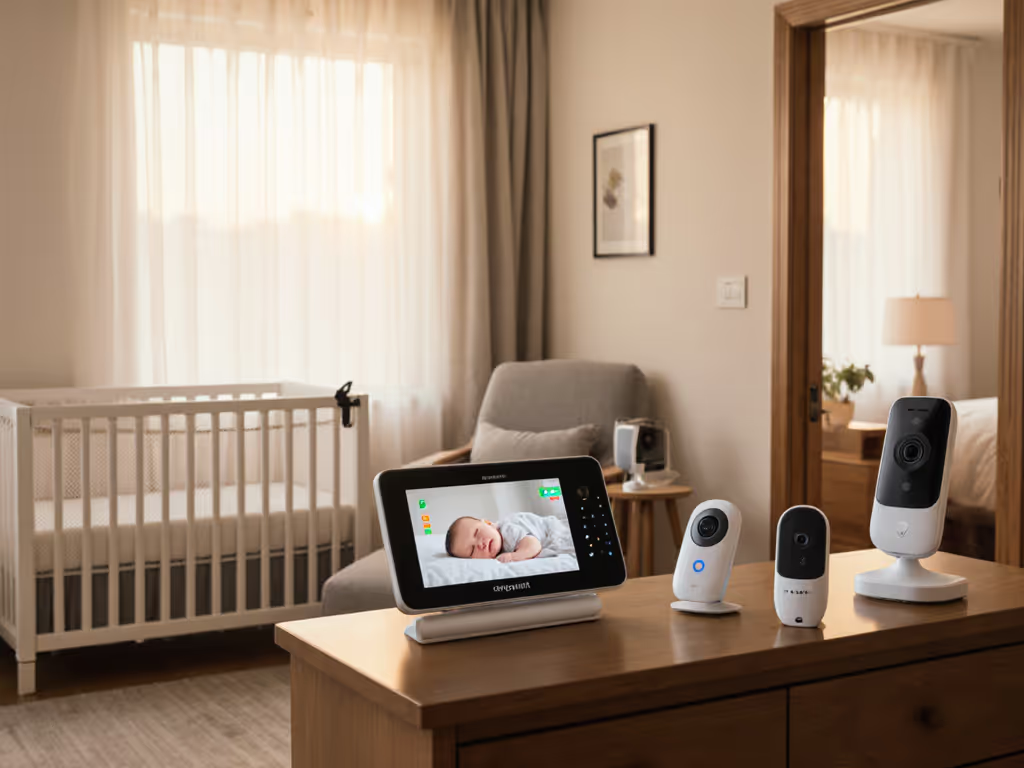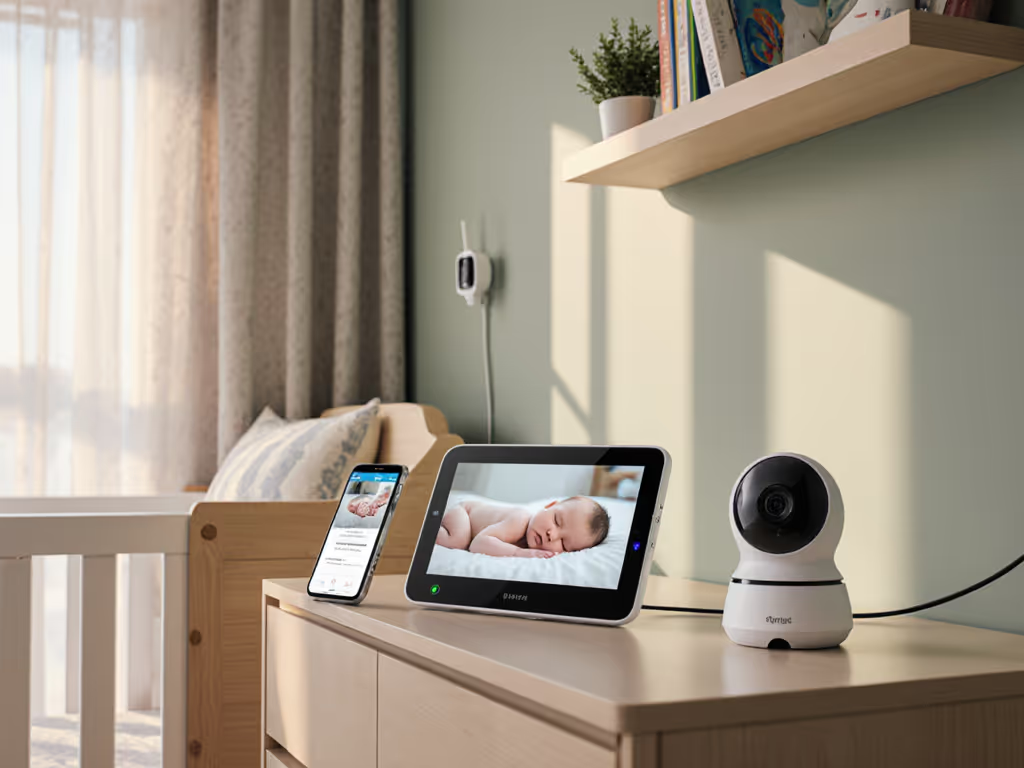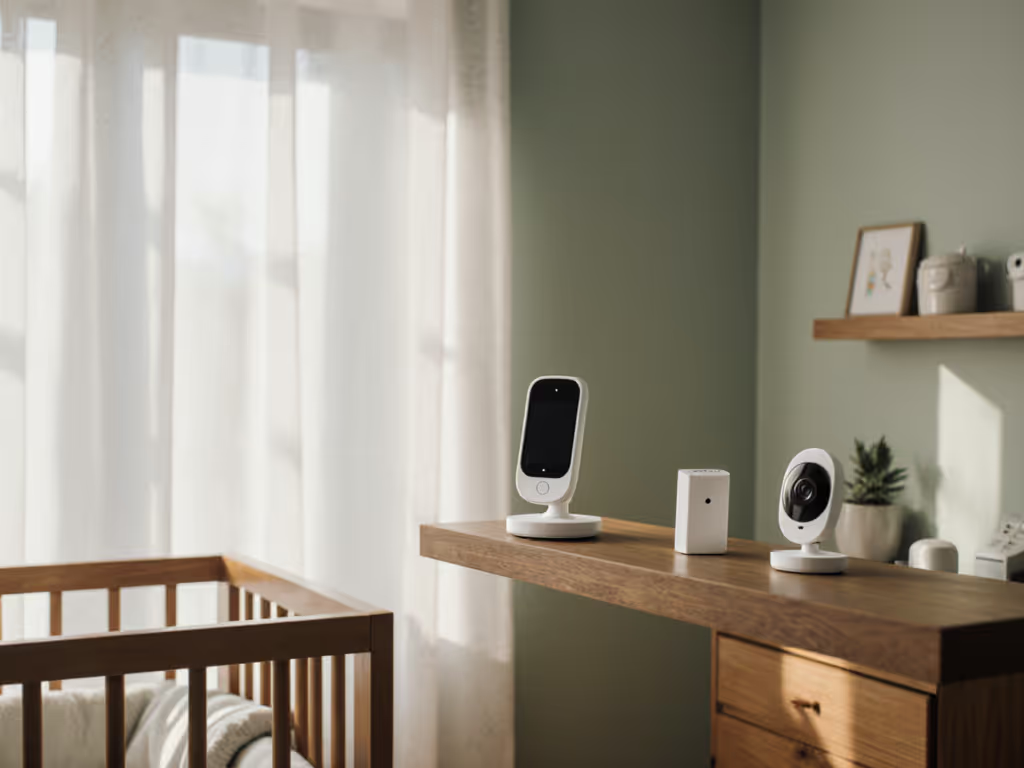
Video Baby Monitor Explained: Key Types and Features
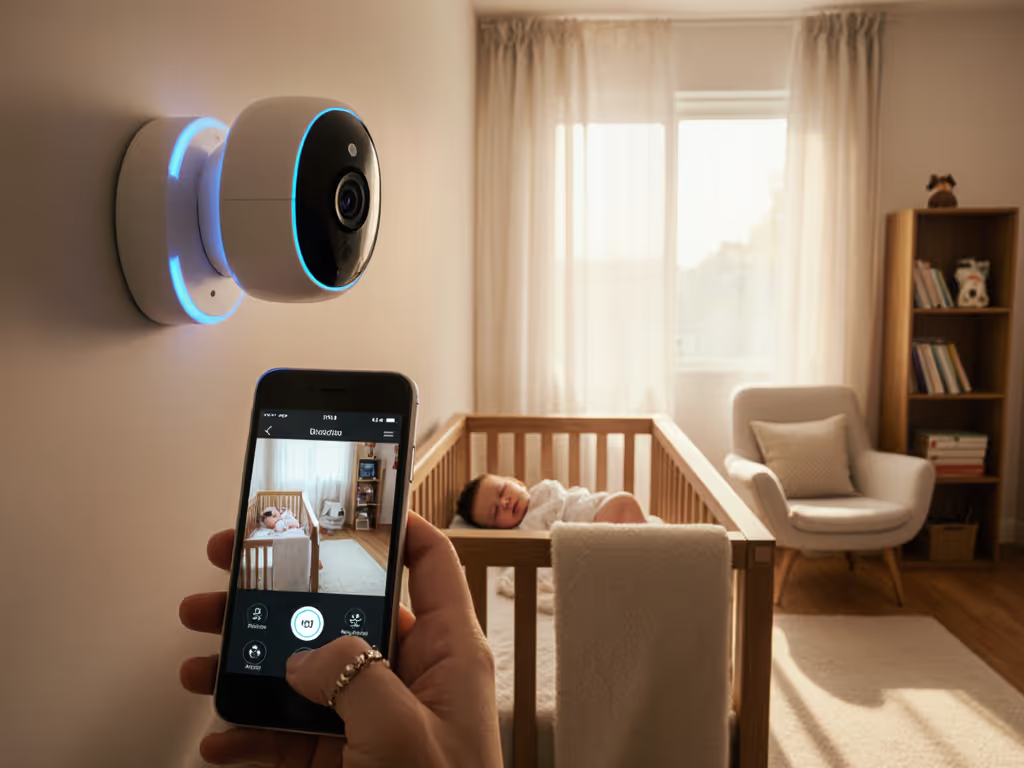
Did you know that over 70 percent of parents now choose video baby monitors over audio-only models? Keeping watch over your baby from another room can ease anxiety and help you respond faster when your child needs you. As technology continues to advance, parents gain even more features and reassurance with new monitoring options, making child safety more accessible and reliable than ever before.
Key Takeaways
| Point | Details |
|---|---|
| Comprehensive Monitoring | Video baby monitors provide real-time audio and visual surveillance, giving parents peace of mind about their child's safety. |
| Variety of Technologies | Different types of video baby monitors (WiFi, RF, Hybrid) cater to various parental needs for connectivity and features. |
| Modern Features | Advanced capabilities such as night vision, two-way audio, and environmental monitoring enhance overall child safety. |
| Privacy and Security | Strong security measures, like signal encryption and password protection, are essential to safeguarding family privacy in digital monitoring. |
What Is a Video Baby Monitor?
A video baby monitor transforms modern parenting by providing a technological window into your child's nursery, offering peace of mind through real-time visual and audio surveillance. Unlike traditional audio-only monitors, these advanced devices leverage digital technology to create a comprehensive monitoring system that keeps parents connected to their babies from another room.
At its core, a video baby monitor consists of two primary components: a stationary camera positioned strategically in the baby's room and a portable parent unit or smartphone app that receives encrypted video and audio transmissions. The camera captures live footage and sound, transmitting this data through secure wireless signals. Modern monitors often include sophisticated features such as:
- Night vision capabilities for low-light monitoring
- Two-way audio communication
- Temperature tracking
- Motion and sound detection alerts
The primary goal of a video baby monitor extends beyond simple observation. These devices provide parents with critical insights into their child's environment, allowing them to quickly respond to potential issues like discomfort, restlessness, or safety concerns. By offering real-time visual and auditory information, video baby monitors have become an essential tool for parents seeking both convenience and comprehensive child monitoring.
Major Types of Video Baby Monitors
Video baby monitors have diversified significantly, offering parents multiple technological approaches to child monitoring. Wireless video monitors represent the most prevalent category, utilizing digital transmission technologies to provide seamless, real-time monitoring across different home environments and configurations.
The primary types of video baby monitors can be categorized into three distinct technological frameworks:
- WiFi-Enabled Monitors: Connect through home internet networks, allowing remote monitoring via smartphone apps
- Radio Frequency (RF) Monitors: Provide direct, localized signal transmission with minimal internet dependency
- Hybrid Monitors: Combine multiple connectivity options, offering flexible monitoring strategies
Each monitor type brings unique advantages tailored to different parental preferences and technological comfort levels.
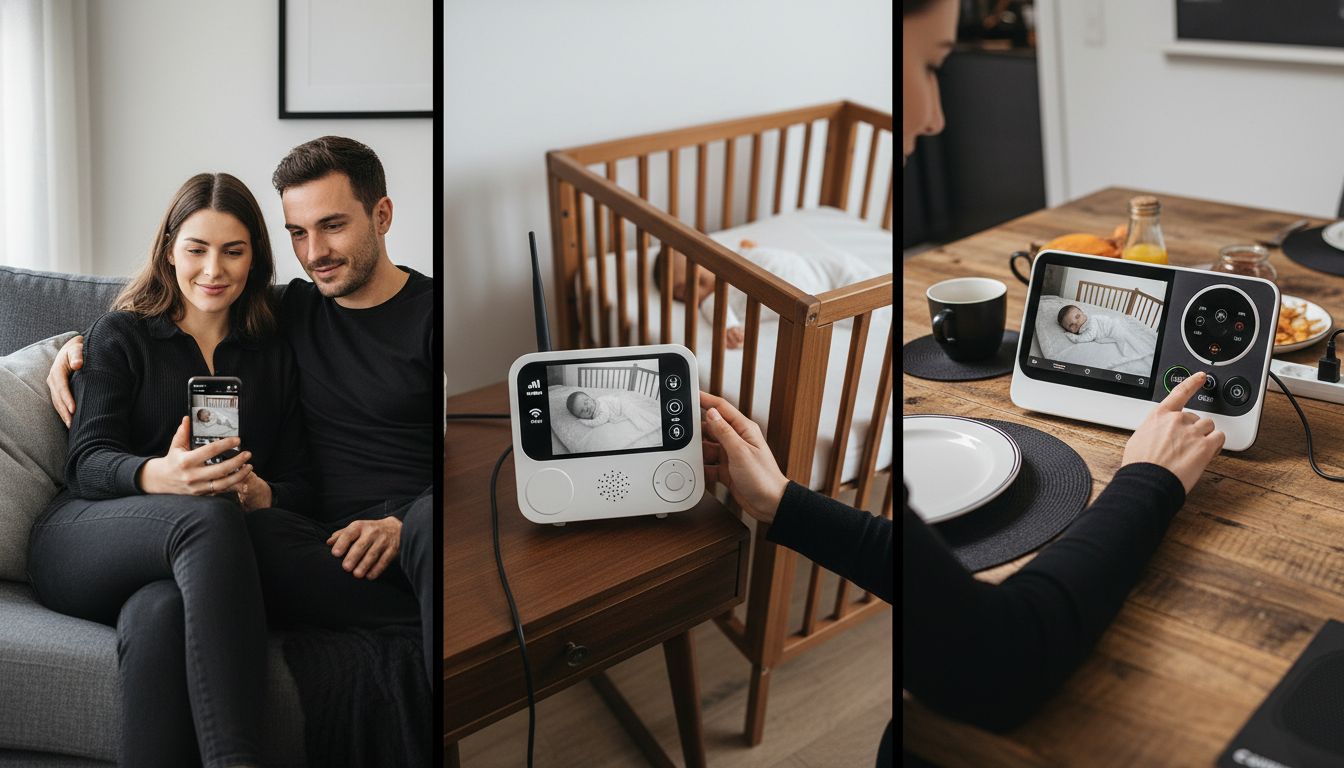 WiFi monitors excel in providing comprehensive remote access and advanced features like cloud storage and sleep tracking. Radio frequency monitors prioritize signal reliability and reduced potential privacy risks. Hybrid systems offer the most flexible approach, allowing parents to switch between connection methods based on their immediate monitoring needs.
WiFi monitors excel in providing comprehensive remote access and advanced features like cloud storage and sleep tracking. Radio frequency monitors prioritize signal reliability and reduced potential privacy risks. Hybrid systems offer the most flexible approach, allowing parents to switch between connection methods based on their immediate monitoring needs.
Here's how the main types of video baby monitors compare:
| Type | Connectivity | Key Advantages | Key Limitations |
|---|---|---|---|
| WiFi-Enabled | Home internet | Remote access<br>Smart features | Depends on internet<br>Higher hacking risk |
| Radio Frequency (RF) | Local RF signal | Reliable connection<br>Lower privacy risk | Limited range<br>Fewer smart features |
| Hybrid | WiFi & RF | Flexible modes<br>Customizable use | More complex setup |
The selection of a video baby monitor depends on critical factors such as home network stability, desired feature set, privacy concerns, and personal technological comfort. Parents should carefully evaluate their specific requirements, considering aspects like signal range, battery life, additional smart features, and overall system reliability when choosing their ideal monitoring solution.
How Video Baby Monitors Work
Video baby monitors operate through a sophisticated system of digital signal transmission, transforming complex technological processes into simple, real-time monitoring solutions for parents. At their core, these devices function as miniature broadcasting networks designed specifically for infant surveillance, utilizing advanced electronic components to capture and relay critical information about a baby's environment.
The technical workflow of a video baby monitor involves several key stages of signal processing:
- Camera Capture: High-resolution digital cameras record visual and audio data from the baby's room
- Signal Encryption: Transmission signals are encoded to prevent unauthorized interception
- Wireless Transmission: Digital signals are sent through secure radio frequencies or WiFi networks
- Parent Unit Reception: Handheld monitors or smartphone apps decode and display the live feed
Modern video baby monitors incorporate multiple technological features to enhance monitoring capabilities. Advanced sensors enable functions like infrared night vision, allowing clear visibility in low-light conditions. Integrated microphones capture sound variations, triggering alerts for potential issues like crying or unusual movements. Some sophisticated models even include environmental sensors that track room temperature, humidity, and background noise levels, providing parents with comprehensive insights into their child's immediate surroundings.
The technological sophistication of video baby monitors continues to evolve, with emerging models leveraging machine learning and artificial intelligence to provide more nuanced, intelligent monitoring solutions. These developments promise increasingly refined ways of keeping parents connected and informed about their child's safety and well-being, transforming traditional childcare monitoring into a high-tech, data-driven experience.
Essential Features and Modern Technologies
Modern video baby monitors have transformed from simple audio devices into sophisticated technological ecosystems designed to provide comprehensive child monitoring. These advanced systems now integrate multiple cutting-edge features that go far beyond basic video and sound transmission, offering parents unprecedented insights and control over their child's environment.
Contemporary video baby monitors typically include an impressive array of intelligent technologies:
- Night Vision Capabilities: High-resolution infrared sensors enabling clear monitoring in complete darkness
- Two-Way Audio Communication: Allowing parents to soothe babies remotely
- Temperature Tracking: Real-time room environment monitoring
- Motion Detection: Automatic alerts for infant movement or potential safety concerns
- Sleep Analytics: Advanced tracking of infant sleep patterns and quality
The integration of smart technologies has revolutionized baby monitoring, with many modern systems leveraging WiFi connectivity and smartphone integration. These intelligent monitors can now provide encrypted, secure transmissions that allow parents to access live feeds from anywhere, receiving instant notifications about their baby's condition. Some cutting-edge models even incorporate machine learning algorithms that can distinguish between normal infant sounds and potential distress signals.
Beyond technological sophistication, these modern monitoring systems prioritize data privacy and security. Encryption protocols, secure cloud storage, and robust authentication mechanisms ensure that sensitive family information remains protected. Parents can now enjoy peace of mind through comprehensive, intelligent monitoring solutions that blend advanced sensor technologies, real-time communication, and stringent privacy protections.
Privacy, Security, and Safety Concerns
Video baby monitors represent a critical intersection of technology and personal safety, where protecting family privacy becomes as important as monitoring infant well-being. Parents must navigate complex technological landscapes that balance convenience with robust security measures to prevent potential digital vulnerabilities.
Key privacy and security considerations for video baby monitors include:
- Signal Encryption: Preventing unauthorized signal interception
- Secure Network Connections: Minimizing risks of remote hacking
- Password Protection: Creating strong authentication barriers
- Regular Firmware Updates: Addressing potential security vulnerabilities
- Limited Data Storage: Reducing digital footprint and exposure risks
The most significant security challenges emerge from potential digital breaches. WiFi-enabled monitors can be particularly susceptible to cybersecurity risks if proper precautions are not implemented. Hackers might exploit weak encryption, default passwords, or unpatched software vulnerabilities to gain unauthorized access to private family moments. Parents should prioritize monitors with advanced security protocols, such as end-to-end encryption, two-factor authentication, and regular manufacturer-provided security updates.
Beyond digital security, physical safety remains paramount. Parents must carefully consider monitor placement, ensuring cameras cannot be easily accessed or tampered with, and selecting devices with robust mounting options. Selecting monitors from reputable manufacturers with proven track records in privacy protection and implementing recommended security practices can significantly mitigate potential risks, transforming these technological tools into reliable, secure child monitoring solutions.
Video Baby Monitors vs. Other Options
Modern parenting technologies offer diverse monitoring solutions, with video baby monitors representing the most comprehensive approach to infant surveillance. Unlike traditional alternatives, these advanced systems provide parents with unprecedented visual and auditory insights into their child's environment, dramatically transforming how families approach childcare monitoring.
Compared to alternative monitoring options, video baby monitors offer distinct advantages:
- Audio Monitors: Limited to sound detection, lacking visual confirmation
- Smart Home Cameras: Less specialized, without infant-specific features
- Mobile Phone Apps: Require constant device engagement and battery management
- Traditional Analog Monitors: Vulnerable to signal interference and limited range
The primary differentiator for video baby monitors lies in their specialized design and comprehensive monitoring capabilities. While audio monitors provide basic sound tracking, video monitors deliver real-time visual confirmation of an infant's condition, including movement, breathing patterns, and environmental interactions. Smart home cameras, though technologically advanced, often lack dedicated infant-specific features like temperature tracking, two-way communication, and specialized night vision optimized for baby rooms.
Ultimately, the choice between monitoring options depends on individual family needs, technological comfort, and specific environmental considerations. Video baby monitors represent the most advanced solution, offering peace of mind through comprehensive, purpose-built technologies that address the nuanced monitoring requirements of modern parenting. Their ability to provide instant, detailed insights makes them an increasingly essential tool for parents seeking both convenience and comprehensive child safety monitoring.
Discover the Perfect Video Baby Monitor for Your Family
Choosing the right video baby monitor can feel overwhelming with all the options and features available. This article highlighted key challenges such as signal reliability, privacy concerns, and selecting between WiFi-enabled, RF, or hybrid monitors. You want a trustworthy device that keeps your baby safe, respects your privacy, and fits your home environment without fuss.
At babymonitorsforparents.pro we understand how important it is to make an informed decision. Explore our expertly crafted buying guides and in-depth reviews that break down complex terms like encryption, night vision, and two-way audio into simple, actionable advice. Whether you worry about your home WiFi security or want reliable offline monitoring, our resources address your concerns with real-world performance insights.
Ready to find the best video baby monitor that gives you peace of mind every night? Visit babymonitorsforparents.pro now for trusted recommendations and start securing your baby’s comfort and safety today.
Frequently Asked Questions
What is a video baby monitor and how does it work?
A video baby monitor is a device that provides real-time visual and audio surveillance of your baby through a camera in their room and a parent unit or smartphone app. It operates by capturing live footage and sound, encrypting the data, and transmitting it wirelessly to keep parents informed about their child's environment.
What are the main types of video baby monitors?
The main types of video baby monitors include WiFi-enabled monitors, which connect via home internet for remote monitoring, radio frequency (RF) monitors that provide localized signal transmission, and hybrid monitors that combine both WiFi and RF technologies for added flexibility.
What essential features should I look for in a modern video baby monitor?
Look for features such as night vision capabilities for low-light monitoring, two-way audio communication to soothe your baby remotely, temperature tracking to monitor room conditions, and motion detection alerts to notify you of any movement or safety concerns.
How can I ensure the privacy and security of my video baby monitor?
To ensure privacy and security, select a monitor with signal encryption, secure network connections, and strong password protection. Regularly update the firmware and be cautious about monitor placement to prevent unauthorized access to the camera feed.

